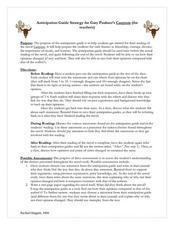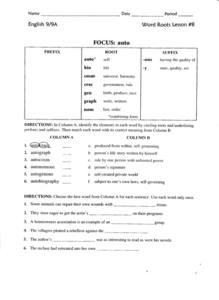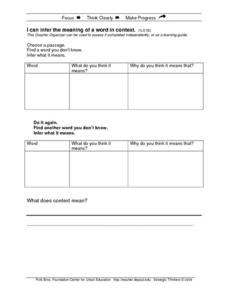Curated OER
Fluency: Read Regular Words
Second graders engage in a timed choral reading activity to practice reading with accuracy and fluency. The teacher starts the timer and taps a reading rhythm on the desk as the class reads a series of words in unison. When the time is...
Curated OER
Puzzle Page
Who says your budding readers are too young for crossword puzzles? Scholars use visual clues instead of written ones to complete single-syllable words. They fill in the initial letter for each of six words, and a second letter for one of...
Curated OER
"A Sound of Thunder" by Ray Bradbury: Questions
These questions are designed to accompany Ray Bradbury's "A Sound of Thunder," and could be used to guide and focus readers or as an assessment of reading skill and knowledge of the elements of a story. Page one focuses on questions of...
Curated OER
Anticipation Guide Strategy for Gary Paulsen's Canyons (For Teachers)
"Things never change." "It's okay to steal from those who already have a lot." Before reading Canyons, readers respond to an anticipation guide that focuses on issues raised in Gary Paulsen's novel. Groups share their responses, and...
Curated OER
Definite and Indefinite Articles
Quiz your beginning Spanish speakers on their use of definite and indefinite articles. Through two short exercises, they review el, la, un, and una. With the first activity, they write the correct Spanish article for each word. In the...
Brigham Young University
Bloom’s Taxonomy: Questions for Harry Potter and the Chamber of Secrets
As part of their study of Harry Potter and the Chamber of Secrets, readers respond to a series of questions based on chapter eight of J.K. Rowling's second novel in the series about the famous young wizard.
Brigham Young University
K-W-H-L for Harry Potter and the Chamber of Secrets
To prepare for a study of Harry Potter and the Chamber of Secrets, the second in the series of seven books about J.K. Rowling's amazing young wizard, readers complete a K-W-H-L chart.
Curated OER
Night: Socratic Questioning Activity
We construct meaning through discussion, so help your readers of Elie Wiesel's work Night with a socratic questioning activity. The strategy is outlined on the first page, and the second page offers some example questions you give to...
Curated OER
Handout #3-Setting Found Poems
What is a Found Poem? Use excerpts of the setting presented in John Steinbeck's Of Mice and Men to inspire Found Poetry. An explanation is given, and the second page houses an example of a Found Poem inspired by Black Boy, but you'll...
Curated OER
Word Roots Lesson #8: auto
Knowing root words can expand our vocabulary dramatically. Use this worksheet to discuss auto and words in which it commonly appears. Two short exercises are provided here. In the first, learners match words containing the target root...
Curated OER
Jane Eyre: Vocabulary Worksheet List 2
Anathema, brooch, sonorous? Readers may grimace as they complete two exercises based on vocabulary found in Jane Eyre. After crafting original sentences using one set of words, they draw words from a second list to complete a series of...
Curated OER
Our Town List 1 Worksheet
Build vocabulary while reading Our Town, Thornton Wilder's Broadway play. This two-page resource highlights 20 tricky vocabulary words like alacrity, epitaph, languid, and vestige. In the first activity, pupils answer questions that use...
Curated OER
Appositives
Instruct your class on appositives and they will be ready to complete this sentence-combining activity. Given two sentences, one of which describes the subject in detail, pupils are asked to incorporate the second sentence into the first...
Shmoop
ELA.CCSS.ELA-Literacy.RI.11-12.7
Comparing information found in images, charts, and graphs with that found in written text can be a challenge for even senior high scholars. Provide learners with an opportunity to practice this skill with an exercise that asks them to...
Polk Bros Foundation
I Can Infer the Meaning of a Word in Context
Work on developing strategies for determining the meaning of unknown words and phrases with a quick context clues exercise. Class members choose two words from their reading and write down what they think they mean and why. See the...
Polk Bros Foundation
I Can Identify a Nonfiction Writer's Main Idea and Supporting Examples
Use this page to quickly identify the central idea of a text and organize ideas for writing an informational or explanatory text. The worksheet is split into two parts. In the first part, pupils note down the main idea and supporting...
School Magazine
Horrible Homonyms!
Park/park, spring/spring. do your class members need extra practice with homonyms? The first exercise on this worksheeet asks learners to identify the homonym, while the second asks kids to identify at least two meanings of the word listed.
Novelinks
The Dark Is Rising: Guided Imagery
To launch a reading of The Dark is Rising, the second novel in Susan Cooper's award winning contemporary fantasy novel sequence for young adults, class members engage in a guided imagery exercise that asks them to visualize the setting...
School District of Palm Beach County
Framed Paragraphs characterization, problem and solution, symbolism, conflict
Support your learners as they work on writing paragraphs by providing graphic organizers, outlines, and frames. Sift through this packet to find the perfect organizers and templates to prepare pupils for writing. The resource...
Curated OER
Accent Marks & Special Characters in Spanish
Check out this clear description of how and when to use accent marks and special characters. The information, necessary to truly understand the purpose of special characters and accent marks would make a great reference material for...
Fluence Learning
Writing an Argument: Is Electronic Communication Helpful or Harmful?
Technology has undoubtedly improved the lives of people around the world—but has it improved communication? Seventh graders read two informative passages about the rise of texting and emailing versus in-person conversations before...
K12 Reader
Have You Got the Time?
Time and time measurement is the subject of a comprehension worksheet that asks kids to read a short passage about time, and then respond to a series of questions based on the article.
K12 Reader
Classifying Triangles
Bring math and reading informational text together with a reading comprehension lesson. After kids read about isosceles, scalene, and equilateral triangles, they answer five comprehension questions to demonstrate how they can use context...
Pearson
Past Time
How do you talk about things that have already happened? What about things that happened in the past and are still happening? Explore past, past perfect, and past progressive verb tenses in a helpful slideshow presentation.

























